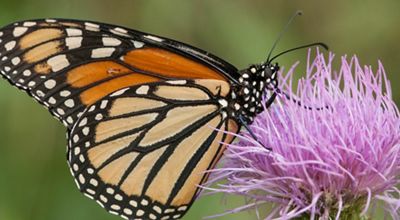Native Gardening in Oklahoma
Helpful tips, tricks and resources for your garden.
When it comes to planting a garden, native plants are best. They require the least maintenance, are beneficial to native pollinators such as bees, bats and monarch butterflies, and many return year after year. Plants native to Oklahoma—like those found at the Joseph H. Williams Tallgrass Prairie Preserve—are conservation powerhouses, enriching and renewing our soils while providing essential nutrition for thousands of insects and animals. Using native plants and trees on your landscape helps Oklahoma’s wildlife flourish and prevents the spread of invasive plant species and the problems they can cause. Below you will find helpful tips, tricks and resources on planting wildflowers, avoiding problems with city ordinances and resources for landscaping and identifying wildflowers.
PLANTING WILDFLOWERS
When to plant: Almost all perennial and many annual plants are best planted in the fall months of September, October, and November, while seed is best planted in September and October. Plants can also be planted in the spring near the frost-free date.
Where to plant: Most of the wildflowers in our area require several hours of sunlight. They will usually do well in most soils as long as drainage is adequate. Those wildflowers that prefer shade will probably require alteration of the soil not discussed here.
Preparation of area: Although use of herbicides is usually not recommended, grassy areas are best treated with a glyphosate-containing herbicide. These must be applied to green vegetation well before seeding. Allow at least 2 weeks before seeding the area after application of the herbicide. Use the herbicide sparingly and be controlled in the application.
Alternatively, you can cover the dormant turf grass with several sheets of newspaper, then cover that with a couple of inches of sand, compost, or a mixture of the two. Mow any dead vegetation as short as possible
Seeds: Seeds purchased from a local source usually will be better adapted to our area. They should come with preparation instructions, since some seeds require special treatment prior to planting. They may require a different planting scheme from that given above because some seeds require light exposure for germination. If you plan on purchasing plants, verify that they haven’t been treated with systemic insecticides. These chemicals can be harmful to pollinators and can negatively affect the soil.
Seeding:
- Lightly rake the area no deeper than ½ inch.
- Hand broadcast the seeds over the area. If you are using a mixture be sure they are properly mixed. Commercial wildflower mixtures usually contain flowers not native to the area, so we encourage you to mix your own.
- Lightly rake the area again to assure good seed-soil contact.
- Spray the area with water.
Care: Water as needed to keep the area moist until seedlings have a couple of true leaves. There is no need for fertilizer. Of course, avoid foot traffic.

AVOIDING PROBLEMS WITH CITY ORDINANCES
There are some who think that only a well manicured lawn is acceptable. Use these tips when dealing with city officials and other authorities, such as HOAs, when defending your garden from complaints.
- Do not have any plants that are noxious or allergenic
- Do not violate any height restrictions near roads
- Take care not to violate any easement requirements
- Be intentional with your space, and consider containing your garden with a hardscape border (stones, fencing, etc)
- Keep records of what you're growing, including its maintenance needs throughout the year
- If you interact with municipal officials (HOA, city employees, etc), keep adequate records of your interactions
- Keep pictures of what your garden looks like through the seasons
- If you're planting for monarchs and other butterflies, register your garden with Okies For Monarchs and utilize their habitat signage

Native Gardening References
These statewide organizations are great resources for native gardeners in Oklahoma:
Please keep in mind that not all general gardening practices translate well when growing native plants. These selections are helpful for the creation and maintenance of your native garden:
- Native Plant Selection Guide for Oklahoma Woody Plants, Darlene Michael, 1995.
- Gardening with Prairie Plants by Sally and Andy Wasawski, published by University of Minnesota Press, 2002.
For identifying our native wildflowers and trees:
- The Guide to Oklahoma Wildflowers, Pat Folley, University of Iowa Press, 2011.
- Roadside Wildflowers of Oklahoma, Doyle McCoy, University of Oklahoma Press, 1981.
- Field Guide to Oklahoma Plants, Ronald Tyrl, Terrence Bidwell, Ronald Masters, Oklahoma State University, 2002.
- Forest Trees of Oklahoma, revised by Elbert Little, Jr. Oklahoma Forestry Service, 2002
- An Annotated List of the Ferns, Fern Allies, Gymnosperms and Flowering Plants of Oklahoma, John and Constance Taylor, "ONPS", 1994.
- Illustrated Flora of North Central Texas, George Diggs, Barney Lipscomb, Robert O'Kennon, BRIT, 1999.
Support Our Work
Donate now to help ensure a thriving natural environment for future generations in Oklahoma.



